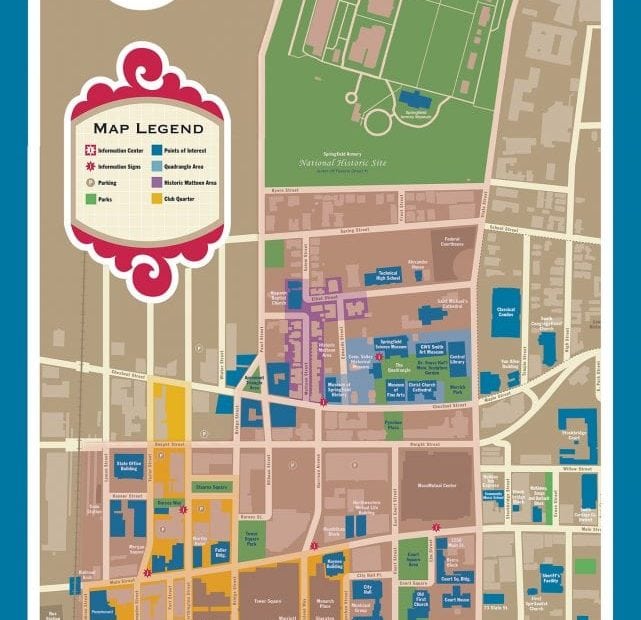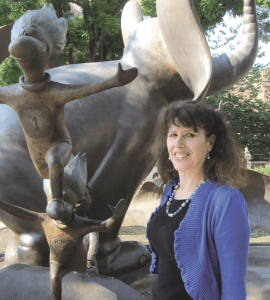
Creating a Sense of Place
Springfield Seeks State Designation for a Cultural District

Kay Simpson says creation of a cultural district will help Springfield brand its many attractions, while spurring economic development.
Evan Plotkin equated it to a business hanging out a sign that reads “under new management.”
Though he quickly acknowledged that the analogy isn’t perfect — the city hasn’t actually changed leadership at the top, and won’t for at least a few more years — he went ahead with it anyway, because he considers it an effective way to talk about what the creation of a cultural district in Springfield can and likely will do for the community.
“Business owners put out an ‘under new management’ sign on a restaurant, for example, when they want to change the dynamic,” said Plotkin, president of NAI Plotkin and a prime mover in ongoing efforts to revitalize and promote the city’s downtown. “They do it because they want people to know that something has changed, something’s different, something’s better — that people should want to come there again.”
Creating a cultural district can do very much the same thing for Springfield, he went on, noting that it will help the city brand itself and its many cultural attractions and, in many ways, give people a reason to give the community a look — or another look.
Kay Simpson agreed. She’s the vice president of Springfield Museums and one of the primary architects of a proposed cultural district that would cover several blocks downtown and include everything from the Armory Museum to the Paramount; from the Community Music School to the five museums in the Quadrangle; from Symphony Hall to the clubs on Worthington Street.
The formal application for creation of the district was sent to the Mass. Cultural Council (MCC) on Aug. 15, said Simpson, who literally knocked on some wood as she talked about what she considers decent odds that the city will join Pittsfield, Easthampton, Lowell, Gloucester, and other cities gaining state designation for a cultural district.
“This is a great tool for promoting the arts,” she said, adding that, beyond building awareness of the city’s attractions, creation of a cultural district will also better position the city for funding from such organizations as the National Endowment for the Arts, and also spur economic development. “A district can stimulate business, especially creative-economy businesses.”
Her optimism about the proposal’s chances is based on comments made by MCC officials who have walked the planned district already and provided input on the application and how it should be written, and also on the large volume of attractions and institutions packed into the multi-block area identified in the map to the right.
 “It’s remarkable when you consider how many major cultural institutions are located in the downtown area,” she said. “This is not a huge geographic area, but there is a dense concentration of cultural assets.”
“It’s remarkable when you consider how many major cultural institutions are located in the downtown area,” she said. “This is not a huge geographic area, but there is a dense concentration of cultural assets.”
David Starr concurred. The president of the Republican and chair of the city’s Cultural Coordination Committee described the planned district as a “true gem,” and said its creation will provide new and potent opportunities to increase awareness of the city’s cultural amenities and build on that foundation.
“The problem has always been that these institutions never got the outside recognition that they deserved,” he explained, referring to the museums in the Quadrangle, the symphony, and other organizations. “A cultural district will help sell them and help brand them to not just the local area, but people outside this region.”
For this issue and its focus on travel and tourism, BusinessWest takes an in-depth look at the proposed cultural district and what its architects believe it can do for the city and its ongoing efforts to revitalize the downtown area.
Mapping Out a Strategy
The MCC’s Cultural Districts Initiative was authorized by an act of the state Legislature in 2010 and launched in 2011.
It was inspired by mounting evidence that thriving creative sectors stimulate economic development, said Simpson, noting that the prevailing theory has been that such districts attract artists, cultural organizations, and entrepreneurs, while helping specific communities create or strengthen a sense of place.
“By having the cultural-district designation, you’re creating an environment where all kinds of businesses can come into an area,” she explained. “These creative-economy businesses include everything from art galleries to graphic-design enterprises to coffee shops and restaurants.
“You’re creating a brand for a community,” she went on, “so that people from outside that community know that, if they go to the cultural district in Springfield, there’s going to be a lot for them to do. They can go to museums, see historic monuments and sites, and have lots to do in terms of both the visual arts and the performing arts.”
There are currently 17 cultural districts across the state, with more being proposed. They have been established in Barnstable, Boston, Cambridge, Concord, Easthampton, Essex, Gloucester (which has two), Lowell, Lynn, Marlborough, Natick, Orleans, Pittsfield, Rockport, Sandwich, and Shelburne Falls.
Springfield’s proposed cultural district would be bordered by East Columbus Avenue, Bliss Street, Stockbridge Street, High Street, Federal Street, Pearl Street, Dwight Street, Lyman Street, and Frank B. Murray Street, according to a prepared summary.
That section is home to number of cultural attractions and institutions, including the Springfield Armory National Historic Site, the Quadrangle, the historic Mattoon Street area, the MassMutual Center, Symphony Hall, CityStage, the Paramount, and the Community Music School, said Simpson, adding that it also includes several parks, some retail areas, and a number of restaurants, clubs, and hotels.
One of the required traits of a district, as set down by the MCC, is that it be walkable, said Simpson, noting that, while this comparatively large area — which officials originally thought might encompass two districts — constitutes a “good walk,” it meets that stipulation.
Most of the existing cultural districts have names that identify a specific neighborhood, landmark, or street. Easthampton’s, for example, is called the Cottage Street Cultural District, a nod to the many former mills and storefronts on that thoroughfare that have become home to arts-related businesses and agencies. Meanwhile, Lowell’s Canalway District takes its name from an historic section of that former textile-manufacturing center, which has also become a center for the cultural community, and spotlights the city’s most enduring character trait — its canals.
Those leading the drive for Springfield’s district recently ran a contest to name it; submissions are currently being weighed by a panel of judges, and a winner is to be announced soon.
By whatever name the district takes, it is expected to become a point of reference for Springfield, a vehicle for branding the City of Homes, and a source of momentum as the community seeks to build its creative economy and, overall, bring vibrancy to a long-challenged section of the city, said Plotkin.
In a big-picture sense, the broad goal behind the cultural district is to change the conversation about Springfield, he went on, adding that, in recent years, most of the talk has been about financial struggles (the city was run by a control board for several years), crime, poverty, and high dropout rates in the city’s high schools.
“This cultural district will build a sense of community,” he noted. “It will help break down some of those walls that people have about Springfield, including the sense that we’re a broken city with low self-esteem.
“We have to break out of that and build some pride and some community,” he went on. “We have to start doing things that will really change the city, and I believe a cultural district will do that. Doing this can help to start changing the conversation about Springfield and about what we really are culturally and what we have here.”
It can also help make a community more visible — and attractive — to those looking for landing spots for a company or sites for everything from day trips to meetings and conventions, said Simpson, who said creation of a cultural district in Boston’s Fenway area has apparently done all that.
“In the Fenway, they’ve said they have seen an increase in occupancy rates in office buildings and storefronts since the cultural district was created,” she said, noting that the area, home to several museums and other attractions, is in many ways similar to downtown Springfield. “Meanwhile, it has created for them the sense that they’re more recognized in terms of gaining political support.”
Sign of the Times
Springfield will probably find out sometime this fall if its proposal for a cultural district has been accepted by the MCC, said Simpson.
If all goes as those behind this initiative believe it will, then the city will soon have a new vehicle for marketing itself and perhaps making some real progress in ongoing efforts to change some of the perceptions about the community.
In other words, the ‘under new management’ sign can go on the door. It will then be up the city to make the most of that development. n
George O’Brien can be reached at [email protected]





